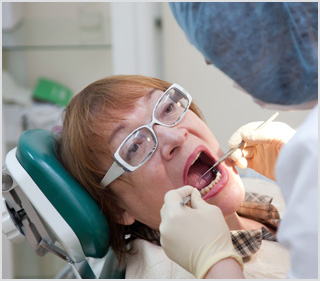Assessing Gum Disease and Cancer Risk
Study: Women with periodontal disease had higher risk of several cancer types.

A new study published in Cancer Epidemiology, Biomarkers & Prevention, a journal of the American Association for Cancer Research (AACR), showed that periodontal disease was associated with increased risk of several types of cancer in postmenopausal women.
Previous research has indicated that periodontal disease is a risk factor for breast cancer, oral, and esophageal cancers. The new study implicates periodontal disease as a risk factor for several more cancer types, said the study’s senior author, Jean Wactawski-Wende, PhD, a professor in the Department of Epidemiology and Environmental Health and dean of the School of Public Health and Health Professions, State University of New York at Buffalo.
The study also indicated that periodontal disease is a risk factor for both smokers and non-smokers, Dr. Wactawski-Wende said.
Periodontal disease, also known as gum disease, is a broad term that can include anything from minor inflammation of the gums to infections severe enough to result in tooth loss, according to the National Institutes of Health.
Seeking to increase understanding of how periodontal disease affects cancer risk, Dr. Wactawski-Wende and colleagues conducted a prospective cohort study of 65,869 women aged 54 to 86 who were enrolled in the Women’s Health Initiative Observational Study. The women self-reported periodontal disease on questionnaires administered between 1999 and 2003. The researchers monitored cancer outcomes through September 2013. Over an average follow-up time of 8.32 years, the researchers identified 7,149 cases of cancer.
The study showed that a history of periodontal disease was associated with a 14 percent higher risk of developing any cancer. The strongest association was for cancer of the esophagus, which was more than three times more likely in women with periodontal disease than women who did not report periodontal disease. Lung cancer, gallbladder cancer, melanoma, and breast cancer were also associated with higher risk.
The researchers noted breast cancer, lung cancer, and gallbladder cancer were associated with higher risk in women who smoked and had periodontal disease. Other types, such as melanoma, were associated with higher risk in the women who had never smoked but did report periodontal disease.
Dr. Wactawski-Wende said the biological mechanisms that connect periodontal disease and cancer are not yet fully understood. She said one possible explanation is that oral pathogens could potentially be carried in saliva and dental plaque, or through diseased periodontal tissues into the blood circulation to reach other body sites and contribute to carcinogenesis; this may possibly explain the strong association in esophageal cancer.
“The esophagus is in close proximity to the oral cavity, and so periodontal pathogens may more easily gain access to and infect the esophageal mucosa and promote cancer risk at that site,” Dr. Wactawski-Wende said.
The authors said that because the study used self-reported data, the prevalence of periodontal disease may have been under-reported. Also, the questionnaires simply asked whether the women had been told they had periodontal disease – not whether their cases were severe or mild.
Further research that uses more precise assessments of periodontal disease could be useful in confirming the link between periodontal disease and cancer, the authors added.
In the meantime, this study adds to a growing body of evidence that oral health is closely linked to overall health.
“Our study findings serve to provide further evidence that periodontal disease is linked to cancer, and support the need for further investigation into how periodontal disease contributes to increased cancer risk,” said the study’s lead author, Ngozi Nwizu, BDS, MMSc, PhD, assistant professor of oral and maxillofacial pathology at The University of Texas School of Dentistry. “This may help direct cancer prevention strategies in the future, including the importance of maintaining good oral hygiene.”
